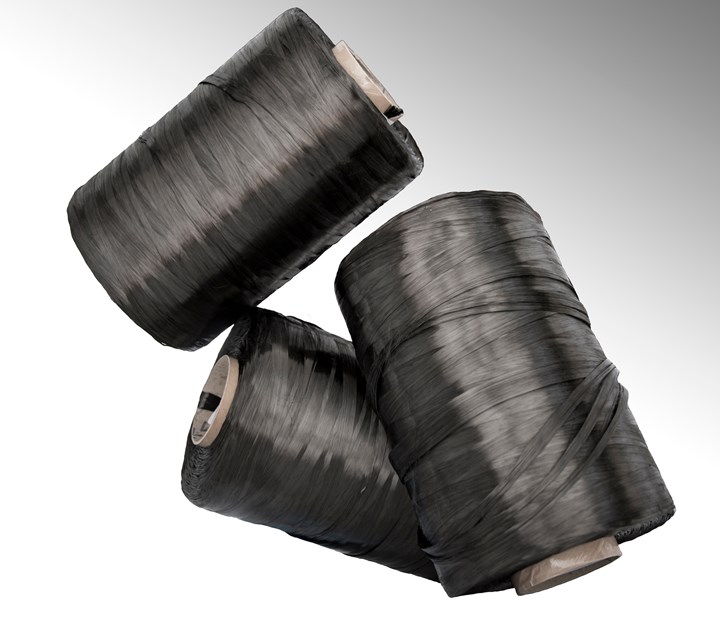"Green" carbon fiber: Renewable energy powers fiber production
Zoltek is first in the industry to use “green” electricity to produce a portion of its heavy-tow carbon fiber.

At its sprawling Nyergesújfalu plant in Hungary, Zoltek Companies Inc. has just started using electricity produced from renewable resources to help produce “green” carbon fiber. With annual production capacity of 15,000 metric tons, the facility is said to be the world’s largest fully integrated carbon fiber plant where polyacrylonitrile (PAN) precursor, carbon fiber itself and downstream, value-added carbon fiber-based intermediates like fabrics and pultruded goods are all produced at a single site. Source | Zoltek
Zoltek Companies Inc. (St. Louis, Missouri, U.S.) is the first carbon fiber producer to use green energy — electricity produced from renewable resources such as wind turbines — to manufacture a portion of its global carbon fiber production.
At the start of the year, Zoltek’s facility in Nyergesújfalu, Hungary began using electricity from renewable resources to power everything from precursor production, to ovens used to carbonize precursor on the way to producing carbon fiber, to intermediate products made from the carbon fiber. “The green electricity is being used for every step of the process, from the moment our raw material enters our facility until the moment the finished carbon fiber leaves as part of a shipment to a customer,” explains Tobias Potyra, Zoltek global automotive director.
This switch in energy sources — at a cost premium that will be borne by Zoltek and not passed on to customers — is estimated to save 5,000 metric tons of carbon dioxide (CO2) annually versus electricity generated by burning coal or natural gas. The plant’s local electricity supplier will issue CO2 certificates to Zoltek based on actual consumption at year’s end.
The significance of this step becomes clearer when the size of the Nyergesújfalu facility it considered. It has an annual capacity of 15,000 metric tons and is said to be the world’s largest fully integrated carbon fiber plant where polyacrylonitrile (PAN) precursor, carbon fiber itself, and downstream, value-added carbon fiber-based intermediates like fabrics and pultruded goods are all produced at a single site. Given how energy-intensive carbon fiber production is, let’s hope that other carbon fiber producers follow suit.

Although it still looks black, a portion of Zoltek’s total global output of industrial-grade (heavy-tow) carbon fiber has just become greener thanks to use of electricity produced from renewable resources that helps offset the greenhouse gases normally generated when electricity is produced by burning coal or natural gas. Source | Török Brigi / BrigiPix Média
Reportedly, the change is being made as part of Zoltek’s internal efforts to focus on sustainability in all areas of its business. “Our carbon fibers enable wind energy to compete with fossil fuels, automobiles to be lighter weight, and batteries to be more efficient, so the shift to renewables to power our own precursor and carbon fiber manufacturing was the next logical step,” explains David Purcell, Zoltek executive vice president. “The proactive use of renewable energy aligns with both our own corporate philosophy as well as the philosophies of many of the industries we serve across the globe whose products already benefit the environment.”
“At Zoltek, we focus every day on ways to make life better for future generations,” adds Nobuya Ando, Zoltek CEO and president. “Using green energy is our responsibility to our customers, our shareholders, and everyone in our communities.”
Zoltek is the global producer of lower-cost, industrial-grade (heavy-tow) carbon fiber and carbon fiber-based intermediates for automotive, wind energy, thermoplastic compounding, offshore drilling, civil engineering, marine and other industrial segments. It was acquired by Toray Group (Tokyo, Japan) in 2014.
Related Content
Novel composite technology replaces welded joints in tubular structures
The Tree Composites TC-joint replaces traditional welding in jacket foundations for offshore wind turbine generator applications, advancing the world’s quest for fast, sustainable energy deployment.
Read MoreNovel dry tape for liquid molded composites
MTorres seeks to enable next-gen aircraft and open new markets for composites with low-cost, high-permeability tapes and versatile, high-speed production lines.
Read MoreInfinite Composites: Type V tanks for space, hydrogen, automotive and more
After a decade of proving its linerless, weight-saving composite tanks with NASA and more than 30 aerospace companies, this CryoSphere pioneer is scaling for growth in commercial space and sustainable transportation on Earth.
Read MoreMoving toward next-generation wind blade recycling
Suppliers, fabricators and OEMs across the composite wind blade supply chain ramp up existing technologies, develop better reclamation methods and design more recyclable wind blades.
Read MoreRead Next
CW’s 2024 Top Shops survey offers new approach to benchmarking
Respondents that complete the survey by April 30, 2024, have the chance to be recognized as an honoree.
Read MoreFrom the CW Archives: The tale of the thermoplastic cryotank
In 2006, guest columnist Bob Hartunian related the story of his efforts two decades prior, while at McDonnell Douglas, to develop a thermoplastic composite crytank for hydrogen storage. He learned a lot of lessons.
Read MoreComposites end markets: Energy (2024)
Composites are used widely in oil/gas, wind and other renewable energy applications. Despite market challenges, growth potential and innovation for composites continue.
Read More


























